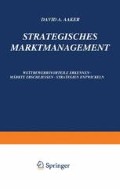Zusammenfassung
Welche strategischen Alternativen sollten betrachtet werden? Welche Alternative ist optimal? Diese Fragen standen bisher hintenan, werden aber in diesem Kapitel und im 12. bis 16. Kapitel zum Hauptthema. Ein Ziel ist, ein Gespür für die Breite strategischer Alternativen zu vermitteln zur Erhöhung der Wahrscheinlichkeit besserer strategischer Entscheidungen. Eine gute Entscheidung bei minderwertigen Alternativen ist weit weniger erstrebenswert als eine schlechte Entscheidung bei hochwertigen Optionen.
Exzellente Unternehmen scheinen alle eine sehr starke Service-Orientierung zu haben, welche die gesamte Organisation durchdringt … ganz gleich, ob ihr Geschäft Metallverarbeitung, Hochtechnologie oder Hamburger sind. Sie alle verstehen sich als Dienstleistungsunternehmen.
Thomas J. Peters und Robert H. Watermann, jr.
Der Fuchs weiß viele Dinge, aber der Igel weiß eine wichtige Sache.
Archilochos, griechischer Lyriker
Access this chapter
Tax calculation will be finalised at checkout
Purchases are for personal use only
Preview
Unable to display preview. Download preview PDF.
Anmerkungen
Stephen E. South, “Competitive Advantage: The Cornerstone of Strategic Thinking”, The Journal of Business Strategy 4, Frühjahr 1981, S. 16.
David A. Aaker, “The Sustainable Competitive Advantage — The Key to Winning”, Arbeitspapier 1987.
David A. Garvin, “What Does ‘Product Quality’ Really Mean?” Sloan Management Review, Herbst 1984, S. 25–43.
A. Parasuraman, Valarie A. Zeithami und Leonard L. Berry, “A Conceptual Model of Service Quality and Its Implications for Future Research”, Report 84–106, Marketing Science Institute, Cambridge, Mass., 1984; A. Parasuraman, Valarie A. Zeithami und Leonard L. Berry, “SERQUAL: A Multiple-Item Scale for Measu ring Customer Perceptions of Service Quality”, Report 86–108, Marketing Science Institute, Cambridge, Mass., 1986.
James M. Carman und Eric Langeard, “Growth Strategies for Service Firms”, Strategie Management Journal, Januar — März 1980, S. 7–22.
Tom Peters und Nancy Austin, “A Passion for Excellence”, New York: Random House, 1985, S. 77.
Hirotaka Takeuchi und John A. Quelch, “Quality Is More Than Making a Good Product”, Harvard Business Review, Juli — August 1983, S. 139–145.
Robert D. Buzell, “Product Quality”, Pimsletter Nr. 4, in: Roger A. Kerin und Robert A. Peterson, Perspectives on Strategic Marketing Management, 2. Aufl., Boston: Allyn & Bacon, 1983, S. 279.
Lynn W. Phillips, Dae R. Chang und Robert D. Buzell, “Product Quality, Cost Position and Business Performance: A Test of Some Key Hypotheses”, Journal of Marketing 47, Frühjahr 1983, S. 26–43; Robert Jacobson und David A. Aaker, “The Role of Product Quality as Part of ‘Strategic Laws of the Marketplace’”, Journal of Marketing, 1987.
John Young, “The Quality Focus at Hewlett-Packard”, The Journal of Business Strategy 5, Winter 1985, S. 7.
Anne B. Fisher, “Spiffing up the Corporate Image”, Fortune, 21. Juli 1986, S. 86.
Theodore Levitt, “Marketing Success through Differentiation of Anything”, Harvard Business Review, Januar — Februar 1980, S. 83–91.
Walter McQuade, “Prince Triumphant”, Fortune, 22. Februar 1982, S. 84–90.
Nancy J. Perry, “The Surprising New Power of Patents”, Fortune, 23. Juni 1986, S. 57.
Carman und Langeard, “Growth Strategies”, S. 9.
Michael Kerr, Michael Kinane, Denis McDuff und Harper Sekijima, “Vercon, Inc.”, unveröffentlicht, 1981.
“How Reyers Stays a Step Ahead”, Time, 15. Oktober 1984, S. 93.
Author information
Authors and Affiliations
Rights and permissions
Copyright information
© 1989 Betriebswirtschaftlicher Verlag Dr. Th. Gabler GmbH, Wiesbaden
About this chapter
Cite this chapter
Aaker, D.A. (1989). Einen dauerhaften Wettbewerbsvorteil erreichen — Differenzierung. In: Strategisches Markt-Management. Gabler Verlag. https://doi.org/10.1007/978-3-322-84578-8_11
Download citation
DOI: https://doi.org/10.1007/978-3-322-84578-8_11
Publisher Name: Gabler Verlag
Print ISBN: 978-3-322-84579-5
Online ISBN: 978-3-322-84578-8
eBook Packages: Springer Book Archive

